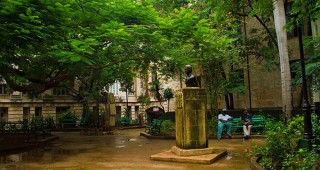Given its strategic location on one side of the harbor mouth, this fortress was one of the two most important defensive constructions in Havana’s defense system in colonial times. Construction works took place from 1590 to 1630, approximately. Along with Castillo de los Tres Reyes del Morro and Castillo de la Real Fuerza, it is one of the three fortresses that appear on coat of arms of the Havana.
It was designed by Giovanni Baptista Antonelli, who also designed the Castillo de los Tres Reyes del Morro (see p…) on the opposite side of the harbour mouth. It was commissioned by Captain General Juan de Texeda, whose name can still be seen cut into a stone in the bulwark to the right of the entrance. Every night for centuries a 250-metre chain boom used to be raised between the two castles to keep out marauding shipping, and the chain’s terminal on the Punta side, three massive upended cannons, can still be seen. The British invasion in the mid 1700s seriously damaged the fort – walk around to the Morro side to see a British cannonball still embedded in the wall. (If the guards make a fuss, ask to see Echeverría the director; he’ll probably escort you and give you a fascinating lecture in English on Havana’s fortifications.) Despite the damage, it was still used for defence in the 19th century. By the time the 20th century came around it was anything but a protective bastion, and at one point was even used as a cow barn.
After extensive restoration, it reopened as a museum in 2002. This effort raised the fortress of San Salvador de la Punta to its original height by clearing out its moat, and unearthed relics spanning five centuries. Initially, La Punta housed some of these artifacts, plus a ship gallery with models of historic vessels and a unique collection of riches – gold bars, emeralds, pieces of eight and treasure boxes – from 16th- to 19th-century treasure galleons which sank off the Cuban coast. But the area’s susceptibility to both the threat and reality of flooding caused by hurricanes, and the resulting necessity to evacuate all the displays, has led to the decision to move these exhibits elsewhere (and to use La Punta as a site museum, with displays from the fortress itself.
Now there are three exhibition rooms displaying a permanent collection about the history of the fortress, its construction, naval modeling and underwater archeology. On the second floor one can still see the urinal and toilet for troops, both interconnected to the drainage sluice from the main square, an impressive step on the road to modern plumbing.









 Scenic view/café
Scenic view/café







